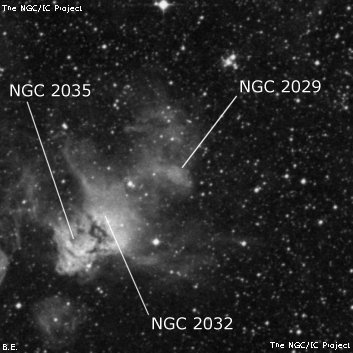
James Dunlop discovered NGC 2029 = D 240 = h2911 on 27 Sep 1826 and noted a "faint round nebula, 25" or 30" diameter." His position is just 4' SW of center of the nebula. JH called this object "a rich, R, pL cluster of stars 12m; little comp; 5' l; one * 11m." On a second sweep he wrote "pB; R; gbM; 60"; resolved into stars 13...15m."
Jenni Kay notes that GC and NGC positions for NGC 2029 and NGC 2030 are reversed from JH's original CGH positions of h2911 and h2910, respectively. The error must have occurred when JH transfered his positions into the GC. So, NGC 2030 = h2030 is part of the Seagull Nebula and NGC 2029 = h2911 is an isolated nebula. All modern sources such as SIMBAD, ESO and the KMHK catalogue reverse the original identifications and call NGC 2029 part of the Seagull Nebula. See WSQJ #108, 4/97. The identifications given here are based on the CGH positions/identifications.
300/350mm - 13.1" (2/20/04 - Costa Rica): fairly bright, fairly large, 3'x1.5', elongated N-S. This LMC object appears to be a large cluster with nebulosity (stellar association LH 83). A half-dozen mag 12-13 stars are resolved over an irregular background haze (unresolved stars?). Located 32' N of mag 6.2 HD 37935. NGC 2003 lies 38' SW. The compact SNR N63A is embedded (not noted).
600/800mm - 30" (10/18/17 - OzSky): at 202x, 264x and 429x; large, fairly bright cluster (S-L 595) with ~30 stars resolved in a 3.5' region and includes at least 4 brighter stars from mag 12.3-13.5 and another mag 12.7 star is at the SW edge. Moderately faint nebulous haze (N63) encompasses the cluster. Adding a NPB filter at 264x increases the contrast with the large nebulous glow, which extended 2.5-3' diameter. Note: this object is identified as NGC 2030 in most sources!
N63A, embedded slightly east of center of N63, is a well-known bright, compact supernova remnant and one of the first 3 extragalactic SNRs to be discovered (1966). The SNR appeared as a small round knot, only ~12"-15" in diameter, and was faintly visible even at 202x. It was easy to distinguish at 264x and stood out fairly prominently at 429x. Surprisingly, I didn't notice any contrast gain adding a NPB filter (similar visibility).
Notes by Steve Gottlieb